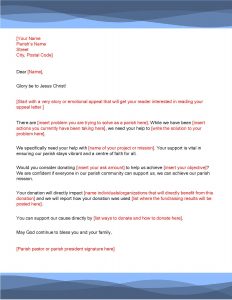Appeal letters are one of the most effective tools your parish can use to raise funds to support the ongoing needs of your parish as well as any special projects. Ensure your parish or district has at least one appeal letter per year. Doing so helps inform people, both parishioners and those in the broader community, of the importance of the activity of your parish and its mission. Here are some tips to help make sure your appeal letters are as effective as possible.
1. Understand the purpose of your appeal letter
First, have a complete understanding of the purpose of your appeal letter and the support you are asking for. All appeal letters should have only one focus for them to be effective.
The top three most common appeal letters are:
Donation Request: Requesting support for general parish operating costs. This letter is often sent towards the end of the year as an incentive for individuals to make a donation and receive a donation tax receipt to apply to their annual income tax returns.
Monthly Donation Request: Often done at the beginning of a new year, a monthly request letter is focused on getting more individuals on a consistent month-to-month donation plan.
Initiative Request: This appeal letter focuses on supporting a specific initiative your parish is undertaking or is planning to undertake in the future.
Again, your appeal letter should only focus on one type of request. Having one letter asking for a monthly donation, a one-time year-end general donation, and a donation which supports a specific project or initiative will only confuse the reader and be ineffective.
2. Understand your audience
Before starting to write your appeal letter, understand to whom you are writing. Answer these questions:
WHO are you writing to? Which languages do they speak? What financial “ask” is reasonable for them? How can we most effectively reach them? When are they most likely to support your mission?
WHERE are they? Where are they located? Will they be directly impacted by the projects you are fundraising for?
WHAT do they value? What are their personal values and how do they relate to what you are asking for?
WHY should they support you? Why should they consider supporting your cause? How does your cause impact them either directly or on a broader scale?
3. Which format is most effective?
A traditional print mail-out is the most effective format for appeal requests. However, try to consider other methods that can be used to get your message out, such as email, for example. Here are six steps to ensure your appeal letter reaches as many potential donors as possible.
- Ask parishioners to update their address and contact information one month before you plan to send out your appeal letter.
- Mail out your appeal letter.
- One week later, insert the appeal letter into parish bulletins to ensure everyone receives a copy and is aware of the campaign.
- Post your appeal letter onto your website accompanied with a video explanation of your campaign, if possible.
- Share the video and the link to your appeal letter on your social media platforms.
- Three days before the ‘final cut-off’ for your fundraising efforts, email your mailing list with one last request. Use a slightly different angle from your original appeal letter to boost interest. A first-hand story from an individual impacted by the project you are raising money for is a great idea for the email campaign.
4. Build a team and schedule
Now that you understand the purpose, audience, and formats of an appeal letter, build a fundraising team to draft and edit the letter and to set deadlines for its delivery. Have at least two individuals for a great exchange of ideas and to keep things on track. Ensure all expectations are written down and understood by everyone.
5. Write your appeal letter
Here are the few key ways to ensure your appeal letter is compelling and delivers the most value:
- Make it personal: There’s nothing worse than a letter obviously printed a hundred times and sent to a hundred different addresses. Taking the extra time to write the name of the individual you are writing to will make them feel valued and not a part of factory printed chain mail.
- Tell your story: Briefly explain your parish’s mission and a story that the reader can directly relate to. This creates a connection between the reader and your cause, something that they can directly recognize and connect with.
- Define the problem: Be extremely honest and clear with the problem your parish faces today.
- Explain the solution: After defining the problem, outline how your parish aims to solve the problem. Then, explain how the reader can directly support your parish’s goal and help to solve the problem.
- Impact: Explain how the reader’s support will directly impact your parish and how it will further your mission both in the parish in and in the community.
- Call-to-action: If the reader reads anything in your letter, it should be the call-to-action. What is the next step they should take right now to help your parish achieve its mission? This should be stated toward the end of the letter.
6. Make your letter POP!
Appeal letters are extremely hard to write but can be very effective if done properly. Here are a few tips to ensure your appeal letter is most effective:
- Focus on YOU:Your letter should be personal and always addressed to the reader. Your letter should be focused more on your reader and their values and less on what your parish does. Your letter should also directly address the reader by using the word ‘you.’
- Unique design and look: Letters written in Microsoft Word on regular stock paper can look very uninspired. Try using slightly thicker paper and make your appeal letter look aesthetically appealing. There are many great and creative templates available online.
- Bold, underline, italicize, CAPITALISE: Do not be afraid to use all four ways in your letter. Bold your call to action. Italicize to stress impactful words. Underline important information.
- Minimalism: Don’t place too many photos, graphics or colours in your letter as they may distract your reader from the text. Afterall, the focus of the letter is the text and any image used should only be used to help the reader relate and connect to your cause.
- Every sentence has a purpose: Write with purpose. Every sentence must havea purpose. Each sentence must achieve something. If you can remove a sentence from the letter and the letter is still effective, remove it. Appeal letters cannot be more than one page.
- Big Ideas Format: Your parish could use the appeal letter as a “big-ideas” vehicle, which focuses on your parish’s overall mission, purpose, goals, and how readers who support your parish can impact their community in a broader context. A second page can be added which focuses on how their donation will make a direct impact on a specific project or initiative. This will help you connect to both the big-idea thinkers and the practical thinkers who prefer seeing charts and numbers.
7. Follow-ups and reflection
Arguably, one of the most important steps of sending an appeal letter is the follow-up and reflection. After running your campaign, personally phone and thank the individuals who supported your cause. This will make them feel like their donation really helped and they will feel appreciated. This will increase the possibility of their future support of any new or recurring fundraising efforts. Also, take time to reflect and discuss everything that went right and wrong with your campaign. Write this down for next year and include different ways you can improve so your campaign will be even more effective next time.


